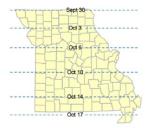COLUMBIA, Mo. – When rain pushes back harvest of corn and soybean, it also means that wheat planting faces delays.
Farmers must decide whether or not to plant wheat this year because of late planting dates. Planting date has a big effect on wheat yield and profitability, said Bill Wiebold, University of Missouri Extension specialist. Growth rate and winter survival are tightly linked to temperature after planting, and the number of warm days is shrinking.
Predicting yield based upon planting date is difficult, Wiebold said. Wheat is a cool-season grass planted in the fall and harvested in late spring to early summer, with a winter dormant period in between. Wheat grows at a minimum temperature of about 40 degrees, but it grows very slowly at lower end of the range.
To maximize growth, three things must happen during the autumn growing period, said MU Extension wheat specialist Brent Myers. First, wheat must develop a root system that resists heaving, which occurs when water freezes and thaws beneath the wheat crown. Second, the wheat needs to store sugars to feed early spring growth and protect the growing point from freezing. Third, wheat plants grow tillers in the fall that produce grain heads in the spring. Lack of warm temperatures reduces the number of tillers that can be produced, resulting in less yield.
Little data exists to predict wheat yield response to planting date, Myers said. In the 2013-14 winter wheat season, MU Extension researchers began an experiment on the effect of planting date on wheat yield at MU’s Bradford Research Center. Wiebold says there is not enough information to develop recommendations yet; results from the first year are similar to data from states adjacent to Missouri.
Perhaps the best place to begin a discussion wheat planting date is with the fly-free date of the Hessian fly, recognized as the optimum date for planting wheat, Wiebold said. The female Hessian fly lays eggs on wheat seedlings. Maggots that hatch from those eggs feed by drinking plant juices from leaves. Adult flies die in early fall when temperatures drop. The fly-free date in Missouri runs Sept. 28 along the Iowa border to Oct. 17 in the Bootheel.
Winter wheat harvested in Missouri in 2014 was down 25 percent from the previous year, according to the U.S. Department of Agriculture report on Sept. 30. Winter wheat yield is estimated at 58 bushels per acre, up 1 bushel per acre from 2013.
Read more http://extension.missouri.edu/news/DisplayStory.aspx?N=2373





